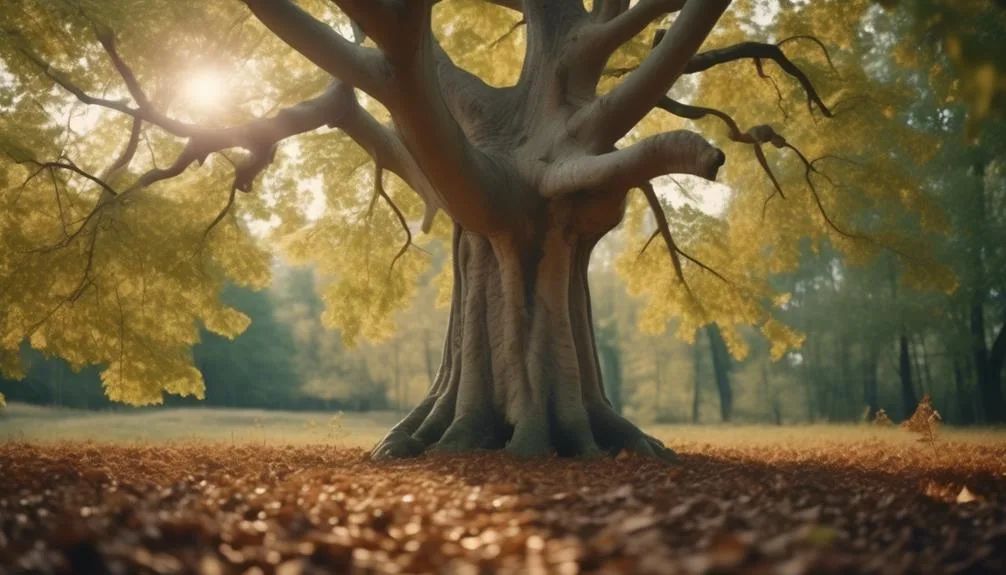Sycamore trees are often seen flourishing alongside other plants, raising questions about their ability to coexist with different species. Their impressive size and beautiful leaves make them stand out, but how do they manage to grow next to other plants?
Understanding this dynamic relationship can reveal the secrets of nature's harmony. Let's explore the intriguing interaction between sycamore trees and their neighboring species to gain insight into their coexistence in the natural world.
Sycamore Trees and Nearby Species
As you walk through the forest, you'll notice the majestic sycamore trees towering over the landscape, casting a cool shade on the ground below and providing a habitat for a variety of nearby species. Sycamore trees are known for their companionship with a diverse range of neighboring trees, creating a rich and complex ecosystem.
Their large, sturdy trunks and broad canopies offer support and shelter for smaller plants and animals. In turn, these neighboring tree species contribute to the overall biodiversity of the area, creating a harmonious environment where different organisms thrive together.
This symbiotic relationship not only enhances the beauty of the forest but also fosters a healthy and balanced ecosystem. Observing the sycamore tree and its neighboring companions, one can appreciate the interconnectedness and interdependence of all living beings in the forest.
Compatibility of Sycamore Trees With Other Species
While sycamore trees form a stunning backdrop in the forest, their compatibility with other species is essential for creating a thriving ecosystem.
Tree competition plays a significant role in determining which species can thrive alongside sycamore trees. Sycamores have a robust growth habit, often competing for sunlight and water. However, their large, deep-reaching roots also allow them to coexist with a variety of other species by accessing different soil layers and nutrients.
Furthermore, sycamores contribute to soil nutrient sharing by cycling and redistributing essential elements, benefiting neighboring plants. Their ability to create niches and foster diverse microhabitats enhances the overall biodiversity of the ecosystem.
Understanding the compatibility of sycamore trees with other species is crucial for sustaining a healthy and balanced environment where different plants can thrive together.
Sycamore Trees in Mixed Plantings
In mixed plantings, sycamore trees thrive alongside a diverse array of plant species, contributing to a rich and dynamic ecosystem. The tree diversity within mixed plantings plays a critical role in enhancing the overall health and resilience of the forest. Sycamores, with their expansive canopies and deep root systems, provide shade and moisture regulation, benefiting neighboring plants. This interplay of species fosters a complex web of interactions, from nutrient sharing to mutual protection. Here's a visual representation of the mixed forest dynamics:
| Benefits of Sycamore Trees in Mixed Plantings |
|---|
| Enhanced ecosystem resilience |
| Improved soil stability |
| Increased wildlife habitat |
The presence of sycamore trees in mixed plantings amplifies the overall biodiversity and ensures a well-balanced and sustainable ecosystem.
Advantages of Growing Sycamore Trees With Other Species
Growing sycamore trees alongside other species offers numerous benefits for fostering a diverse and resilient ecosystem.
The presence of sycamore trees in mixed plantings contributes to increased biodiversity, as it creates varied habitats for different species of plants and animals.
Sycamore trees also support the ecosystem by interacting positively with other species. For instance, their large canopy provides shade and shelter for smaller plants and wildlife, while their deep root systems improve soil structure, nutrient cycling, and water retention, benefiting neighboring species.
Additionally, sycamore trees can attract beneficial insects and birds, which help control pests and pollinate other plants.
These tree interactions enhance the overall health and stability of the ecosystem, making mixed plantings with sycamore trees a valuable strategy for supporting a thriving and diverse natural environment.
Potential Challenges of Sycamore Trees Growing Next to Other Species
Sycamore trees' beneficial interactions with other species can sometimes pose challenges that need to be carefully managed for a harmonious coexistence within the ecosystem. One potential challenge is competition for resources, especially when it comes to root systems.
Sycamore trees have extensive and invasive root systems that can outcompete other plants for water, nutrients, and space. This can lead to stunted growth and decreased vigor in neighboring species. Additionally, the shading effect of the sycamore's dense foliage can further limit the sunlight available for other plants, affecting their ability to photosynthesize and thrive.
To address these challenges, it's important to carefully consider the spacing and planting arrangements when introducing sycamore trees alongside other species. Proper management of the sycamore's root system and monitoring of its competitive effects can help maintain a balanced and diverse ecosystem.
Conclusion
In sum, planting sycamore trees alongside other species brings about a host of benefits, including improved soil health, biodiversity, and pest management.
Embracing diversity in plantings can lead to a flourishing ecosystem. Why not consider integrating sycamore trees into mixed plantings and witness the harmonious coexistence of various species?
Mark Hoffman is a dedicated arborist and tree care specialist with over a decade of experience. His love for trees began when he visited Yosemite National Park as a teenager and was awestruck by the giant sequoias. Mark pursued his passion by studying forestry at Michigan Technological University, where he earned a Bachelor of Science degree.
Since then, he has worked tirelessly in the field of arboriculture, helping to preserve and protect trees in his community. His expertise and dedication have made him a respected leader in the industry and a valuable resource for anyone seeking advice on tree care.
